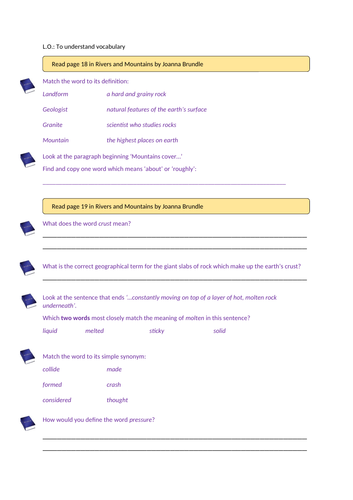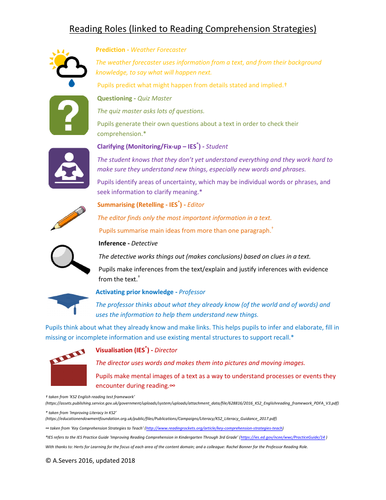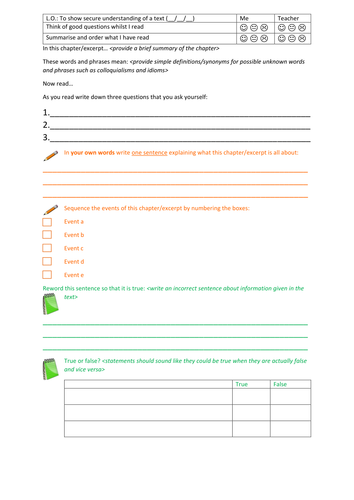
71Uploads
394k+Views
944k+Downloads
English

Picture Book Reading Challenges
2 simple grids with 20 different things per grid to find in picture books
2 more simple grids containing alphabet challenges

Mountains Reading Comprehension Activities
Linked to Reading Roles (https://www.tes.com/teaching-resource/reading-roles-a-way-to-help-children-remember-the-areas-of-the-content-domain-ks1-and-ks2-11416334)
Based on the following books/poems:
Habitat Survival: Mountains by Melanie Waldron
Everest by Sangma Francis
Rivers and Mountains by Joanna Brundle
Asha and the Spirit Bird by Jasbinder Bilan
Unfolding Bud by Naoshi Koriyama

Castle Texts - poems and account of a siege (KS2)
The siege account provides two parallel accounts - one from someone inside the castle defending it, one from someone outside attacking.
One poem is by Alexander Anderson and has lots of great descriptive and figurative language to describe castles.
The other poem is by me and looks at a castle in three time periods - in a time of peace, in a time of conflict and in the modern day.

UKS2 Poetry Booklet
One poem per half term for year 5 and 6 children.
The poems have been selected to represent a diverse range of poets as well as a range of poetic techniques.
Poems could be chosen to link to particular units of work. As such, some of the poems listed here for year 5 might be taught in year 6, and vice versa.
Year 5:
Caged Bird – Maya Angelou (personification, verses, metaphor, repetition, theme, context, anthropomorphism)
Eldorado – Edgar Allan Poe (verses, rhyming couplets, alliteration, structure, archaic language, narrative)
From A Railway Carriage – RL Stephenson (narrative, verses, simile, structure rhyming couplets, rhythm, onomatopoeia, alliteration, repetition)
In Flanders Field – John McCrae (rhyme, alliteration, rhyming couplets, narrative, verses, meter, historic)
The Night Is Darkening Round Me – Emily Bronte (rhyme, theme, structure, verses, historic, meter)
What is Pink? – Christina Rosetti (rhyme, rhythm, meter, repetition)
Year 6:
Be Very Afraid! – Carol Ann Duffy (figurative, repetition, free verse, alliteration, punctuation, humour)
I Wandered Lonely As A Cloud – William Wordsworth (rhyme, verses, historic, simile, metaphor, meter)
If – Rudyard Kipling (verses, historic, repletion, rhyme, theme)
The British – Benjamin Zephaniah (some rhyme, assonance, repetition)
Unfolding Bud – Naoshi Koriyama (verses)
Where The Mind Is Without Fear – Rabindranath Tagore (alliteration, rhythm, some rhyme)

Reading Roles linked to Reading Comprehension Strategies
A slimmed down version of Reading Roles PLUS which focuses only on reading comprehension strategies.

Reading Roles PLUS Generic Reading Comprehension Activity (for use with any text)
Reading Roles PLUS Generic Reading Activity
The aim of this activity is to help children gain a better understanding of a text. It focuses on using 5 of the main widely-acknowledged reading strategies. Although the activity itself has a goal of enabling understanding of one text, the cumulative effect of doing several of these activities is intended to be that children begin to use these strategies automatically when they read any text.
For more on Reading Roles: https://www.tes.com/teaching-resource/reading-roles-plus-teaching-metacognitive-reading-comprehension-strategies-11890964 & http://www.thatboycanteach.co.uk/2018/04/reading-roles-metacognitive-reading-strategies.html

Charlie and the Chocolate Factory Chapters 3 - 11 Comprehension Questions
With various focuses on vocabulary and retrieving and inferring information, particularly about characters.
Colours/symbols linked to Reading Roles: https://www.tes.com/teaching-resource/reading-roles-plus-teaching-metacognitive-reading-comprehension-strategies-11890964

Cosmic by Frank Cottrell-Boyce Reading Comprehension
Reading comprehension questions for various chapters of Cosmic by Frank Cottrell-Boyce.
Focussing on character description, retrieval, vocabulary and inference.

Reading Roles PLUS: Teaching Metacognitive Reading Comprehension Strategies
Reading Roles PLUS is a resource designed to aid children’s metacognition when reading. Metacognition can be defined simply as ‘thinking about thinking’. Reading Roles PLUS takes familiar job titles and assigns them to reading strategies and skills thus giving children an easy-to-refer-to system for being more deliberate with their thinking during reading, with the ultimate goal of being able to comprehend texts. Alongside the job title (or role) there is a symbol which can be used as a further way to prompt certain kinds of thinking – some children may find these easier to remember.
Read more: www.thatboycanteach.co.uk/2018/04/reading-roles-metacognitive-reading-strategies.html

Reading Comprehension Using Photo of Jewish and Muslim Protesters - Trump Muslim Ban
A comprehension activity based on a picture by Nuccio DiNuzzo taken at a US airport where protesters are protesting against Trump's Muslim ban.
The questions focus on inference and do depend on children having some background knowledge, i.e. of the Holocaust.

Mo Farah’s full statement on Trump ‘Muslim ban’ - Reading Comprehension
A quick reading comprehension in response to Donald Trump's 'Muslim Ban' in the US centred around Mo Farah's initial statement outlining his concerns about not being allowed back to the US.
This reading comprehension has colour-coded questions using my 'Reading Roles' which are based on the content domain areas for reading (download them here: https://www.tes.com/teaching-resource/-11416334).

The Battle of Thermopylae Comprehension Work
Focused on vocabulary and summarising texts
Linked to my Reading Roles (see my other TES resources)
Includes 4 different activities in a sequence
Questions are based on this text from The British Museum: http://www.ancientgreece.co.uk/war/story/sto_set.html

Hitler's Canary Supporting Non-Fiction Texts
A range of non-fiction resources to support understanding of key themes and events in Hitler's Canary by Sandi Toksvig.
The sets of questions named by the book's chapters are based on the book and not non-fiction texts.

The Boy in the Dress Reading Activity
A reading resource for a David Walliams excerpt made using an EAL reading comprehension structure: http://thatboycanteach.blogspot.co.uk/2016/12/structuring-reading-comprehension-for.html
With its colour-coding and symbols it also links to my Reading Roles: http://thatboycanteach.blogspot.co.uk/2016/12/reading-roles-cognitive-domains-made.html - a way of making the cognitive domains memorable for staff and children.

EAL reading comprehension activity structure
http://thatboycanteach.blogspot.co.uk/2016/12/structuring-reading-comprehension-for.html

Scaffolding Inference - a technique to help children to infer meaning from texts
Condensed from http://thatboycanteach.blogspot.co.uk/2016/10/scaffolding-inference-trialling.html
This is an explanation of on easy questioning technique to build children's understanding of what they are reading, focusing particularly on inference and how inference can be supported by vocabulary knowledge and information retrieval skills.
The symbols/colours are linked to: https://www.tes.com/teaching-resource/reading-roles-a-way-to-help-children-remember-the-cognitive-domains-ks1-and-ks2-11416334

Questions for Wonder by RJ Palacio (Via's section)
These questions are colour-coded and linked to symbols from my Reading Roles and some follow my scaffolding inference technique:
http://thatboycanteach.blogspot.co.uk/2016/10/scaffolding-inference-trialling.html

Questions for 1st section of Wonder by RJ Palacio
Many of these questions have been written using this technique: http://thatboycanteach.blogspot.co.uk/2016/10/scaffolding-inference-trialling.html and some of them draw on ideas from Rhoda Wilson: https://misswilsonsays.wordpress.com/2016/10/02/moving-beyond-reading-comprehension-sheets/

Reading Roles - a way to help children remember the areas of the content domain (KS1 and KS2)
Each of the new cognitive domains for reading has been linked to a well-known career/job/role in order to make each of the areas of the content domain easier to remember for both children and teachers.
Each area has a symbol and is colour-coded so that there are further ways for the children to remember the areas and what they mean.
These could be used to colour-code questions used in class - the symbols could also be assigned to question types so children begin to identify question types.




















